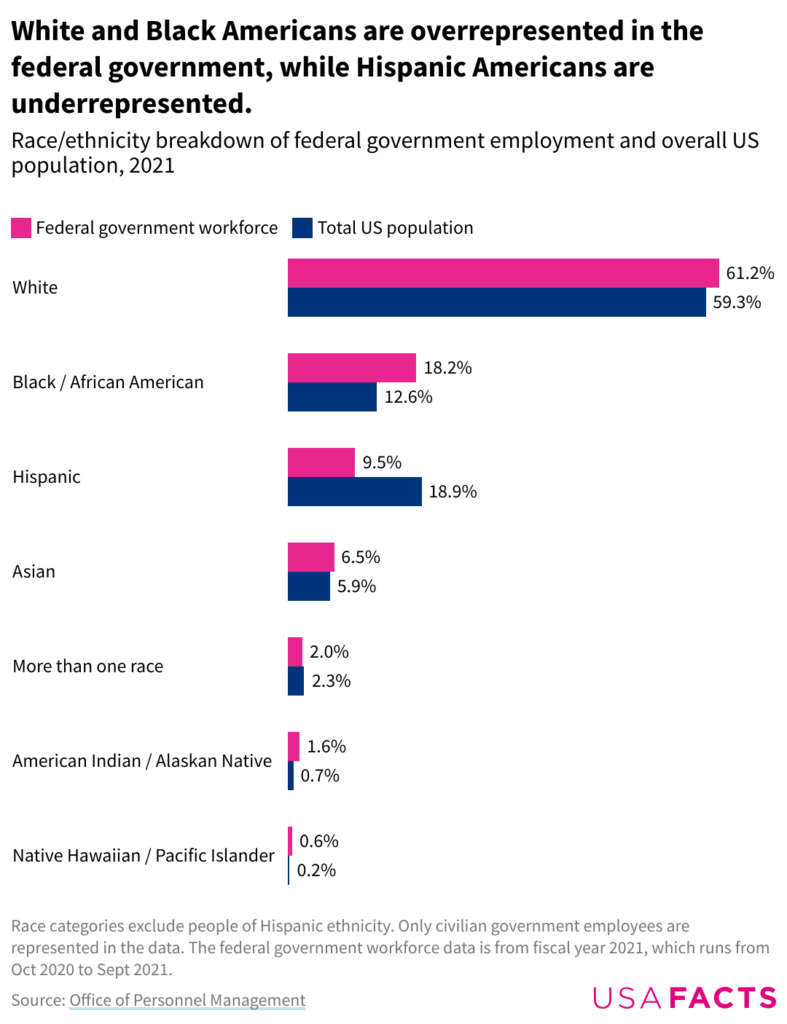I’m attempting to be unbiased when writing; the following will analyze the Phillip Scott podcast. The following content is not an attack post but a critical-thinking post. Let’s go over the facts, data, and statistics regarding the claims made in this video.
Demographics and Representation

The federal workforce is pivotal in early 2025, with proposed changes threatening a historically vital pathway to economic stability for Black Americans. Current data reveals progress and persistent challenges in federal employment’s role as an economic equalizer.

Black Americans comprise 18.2% of federal employees and 13.7%1 of the U.S. population (USAFacts, 2023).2 This higher representation reflects decades of intentional policy dating back to the Civil Rights Act 1964. However, significant disparities persist – Hispanic Americans remain notably underrepresented at 9.5% despite comprising 18.9% of the population (Government Executive, 2023).
- Overall, black Americans are over-represented in this specific sector, so cuts would factually affect black Americans more.
Economic Stakes
The unemployment landscape underscores the critical nature of federal employment for Black workers:

• The Black unemployment rate stands at 6.5% compared to 3.1% for white workers (Economic Policy Institute, 2024).3
• In Washington DC, Black unemployment has reached 10.8% (Bloomberg, 2025).4
• The Black-white unemployment ratio remains 2-to-1 nationally (Economic Policy Institute, 2024).
With unemployment rates currently high in Washington, DC, the impact on black Americans for cuts would make the economic situation more complicated. Youth unemployment in DC statistics are even higher:
- Nearly 1 in 5 young Black workers (19%) are unemployed.
- The Black-white youth unemployment ratio is almost 5-to-1.
- Only 40.5% of Black youth are employed, compared to 61% of white youth.5
To downplay these statistics as something not to worry about is concerning. Logically, is it wise not to care if you are worse off?
4:06 timestamp – Phil highlights that the white unemployment statistics are potentially significantly higher than other demographics. Phil forgets that there is a substantial wealth gap (Cushion) in the White demographic. 6 There is currently an income disparity that exists as well; Black families earn a median income of $45,000 compared to $75,000 for White families.7
These disparities add more context to the discussion and don’t allow for gaslighting of the situation. The point is simple: Cuts to jobs in Black America would not be good.
Historical Context and Wage Equity

Federal employment has served as a crucial equalizer:
• The public sector wage gap between Black and white workers is smaller than in private industry (Center for Economic and Policy Research, 2024).8
• Government jobs provide more stable employment and better benefits (NBC Washington, 2024)9
• Federal employment helped establish much of the Black middle class in the DC metropolitan area (American History, n.d.)10
By 1891, Black workers made up 10% of the federal workforce.11 While it may be factual that no job is guaranteed (8:17) and you can get fired, while you have the job, you have some stability in a world where good jobs are few and far between.
Current Threats

The proposed federal workforce reduction includes the following:
• Relocating 100,000 positions from Washington.12
• Eliminating tens of thousands of additional jobs.
Reinstating Schedule F classification would strip civil service protections (Bloomberg, 2025).13 These changes would disproportionately impact Black workers, who face:
• Less accumulated wealth to cushion job losses.
• Higher unemployment rates.
• Greater difficulty finding comparable private-sector employment (CEPR, 2024).
So, the basic logic behind Phil’s video is to be okay with more challenging times now that Trump is coming into office.
Economic Ripple Effects

The Department of Education faces particular risks due to its high proportion of Black employees. Research shows that Black federal workers are concentrated in administrative and operational roles and are most vulnerable to cuts (Pew Research Center, 2023).14 This threatens recent gains, including a 4.2% increase in Black workers’ average occupational wages since 2019 (Council of Economic Advisers, 2024).15
To ignore the impact of job loss on black Americans is blissful ignorance of the facts; the fact is there is not a lot of wealth for black Americans to fall back on, so there is no benefit to gaslighting the situation if it occurs. A few more facts were missed, such as the average Black family has $8,762 in transaction accounts compared to $49,529 for White families.
• Only 41% of Black households could get $3,000 from family or friends in an emergency, compared to 72% of White households.16
• Black households are more likely to deplete retirement savings during crises, with 14% of young Black Americans having to borrow from retirement accounts compared to 4% of young White Americans.17
Looking Ahead

While government efficiency matters, the historical role of federal employment in advancing Black economic opportunity cannot be ignored. The evidence suggests that proposed cuts would disproportionately impact Black economic mobility, even as total job losses might affect more white workers numerically (UC Berkeley Labor Center, 2020). 18
Any reforms must carefully weigh operational efficiency against decades of progress in creating pathways to middle-class stability for Black Americans.
9:53 In the video, Phil begins to explain his personal experience instead of recognizing the overarching theme that black people will be affected by cuts. We must consider the facts before determining whether an entire group will be ok.
My question to readers is, would you prefer to go to war with a bat or a firearm against a standing modern army?
References
- United States Census Bureau QuickFacts. (n.d.). U.S. Census Bureau QuickFacts: United States. Census Bureau QuickFacts. https://www.census.gov/quickfacts/fact/table/US/RHI225223?t#qf-headnote-a ↩︎
- USAFacts. (2023, March 28). Three charts on diversity in the federal government’s workforce. https://usafacts.org/articles/three-charts-on-diversity-in-the-federal-governments-workforce/ ↩︎
- Economic Policy Institute. (2024, September 18). 2024 Q3 | State unemployment by race and ethnicity.
https://www.epi.org/indicators/state-unemployment-race-ethnicity/ ↩︎ - Bloomberg. (2025, January 15). Trump’s plan to slash federal jobs puts Black workers at risk.
https://www.bloomberg.com/news/articles/2025-01-15/trump-s-plan-to-cut-us-federal-government-puts-black-workers-at-risk ↩︎ - Schnur, C. (2024, December 4). A quality job guarantee would ensure DC youth can fully participate in DC’s economy. DC Fiscal Policy Institute. https://www.dcfpi.org/all/a-quality-job-guarantee-would-ensure-dc-youth-can-fully-participate-in-dcs-economy/?t#_ednref1 ↩︎
- KemeticMinds. (2023, November). The 1968 wealth gap between Black & White Americans remains unchanged in 2023. KemeticMinds Blog. https://kemeticminds.blogspot.com/2023/11/the-1968-wealth-gap-between-black-white.html ↩︎
- National Urban League releases “State of Black America” | National Urban League. (n.d.). https://nul.org/news/national-urban-league-releases-state-black-america-0 ↩︎
- Center for Economic and Policy Research. (2024, December 19). The three labor market struggles facing Black America.
https://cepr.net/publications/the-three-labor-market-struggles-facing-black-america/ ↩︎ - NBC Washington. (2024, November 13). What will Trump’s Department of Government Efficiency do? https://www.nbcwashington.com/news/local/trumps-department-of-government-efficiency-the-dmv-and-federal-employees-what-we-know-so-far/3768335/ ↩︎
- Washington, D.C. – Separate is not equal. (n.d.). https://americanhistory.si.edu/brown/history/4-five/washington-dc-2.html?t ↩︎
- Crawford, D., & Das, K. (2022, February 14). Black workers matter. DC Fiscal Policy Institute. https://www.dcfpi.org/all/black-workers-matter/?t ↩︎
- Agenda47: President Trump’s plan to dismantle the deep state and return power to the American people | Donald J. Trump for President 2024. (n.d.). https://www.donaldjtrump.com/agenda47/agenda47-president-trumps-plan-to-dismantle-the-deep-state-and-return-power-to-the-american-people ↩︎
- Federalworkerrights. (2025, January 13). Schedule F: What federal employees need to know. Federal Worker Rights. https://federalworkerrights.com/2024/12/09/schedule-f-what-federal-employees-need-to-know/?t ↩︎
- Pew Research Center. (2023, August 31). Black workers’ views and experiences in the U.S. labor force stand out in key ways. https://www.pewresearch.org/short-read/2023/08/31/black-workers-views-and-experiences-in-the-us-labor-force-stand-out-in-key-ways/ ↩︎
- Council of Economic Advisers. (2024, May 16). Recent labor market conditions for Black workers.
https://www.whitehouse.gov/cea/written-materials/2024/05/16/recent-labor-market-conditions-for-black-workers/ ↩︎ - Gould, E., & Wilson, V. (2020). Black workers face two of the most lethal preexisting conditions for coronavirus—racism and economic inequality. Economic Policy Institute. https://www.epi.org/publication/black-workers-covid/ ↩︎
- Federal Reserve Bank of Minneapolis. (2024). Risky employment, safe assets, and the racial wealth gap. https://www.minneapolisfed.org/article/2024/risky-employment-safe-assets-and-the-racial-wealth-gap ↩︎
- UC Berkeley Labor Center. (2020). Black workers and the public sector. https://laborcenter.berkeley.edu/black-workers-and-the-public-sector/ ↩︎



Leave a Reply